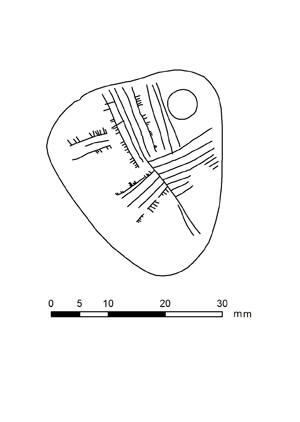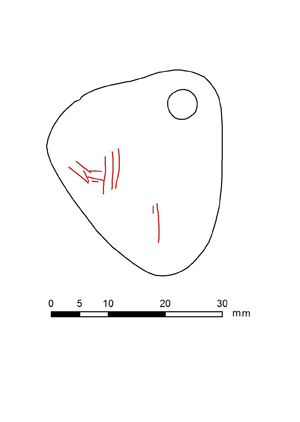

Analysis of line order reveals two major phases of lines, as expressed in Figure 16. The majority of lines conform to a pattern of intersecting earlier phases of engraving at a perpendicular angle. Some of these arrangements conform to Clark's (1936, 169) barbed line type C designs. A repeating element emerges in this arrangement, with longer lines later intersected by smaller lines. This is most evident with the smaller, tightly packed groups of lines, expressed as sub-phases above. These barbed line groups always feature at the outermost lines of a series of longer lines and repeat across multiple orientations. This very specific pattern suggests they might have been produced contemporaneously. On the grounds of orientation, an additional phase emerges, which does not entirely conform to this pattern. Lines are grouped, parallel and of a similar length, though markedly less so, with a significant spatial dislocation in those lines running 'north'/'south'.


The chronology of these differing working styles is difficult to discern. There is no unambiguous point of connection between phases 3 and 4. It could be the case that the more erratic pattern is the earliest engraving. The later engraving of the more heavily ordered phases might have cut over the top of a pre-existing design, of which this is the remnant. This model necessitates heavy wear to the surface, obliterating much of the earlier design through a combination of wear and re-engraving. Given the soft raw material, this is a feasible interpretation. However, the more likely model would instead place the erratic engraving as a later phase that filled areas of empty space. It is interesting to note that those lines which feature small, grouped lines are never subsequently cut by longer lines. If this observation holds true, there was no further room for any long linear lines running 'west–east'/'east–west' to the southern half of the pendant given the placement of the existing arrangements running 'north'/'south'. Instead, the orientation has been changed and further long linears used to fill the gaps. In this model these 'erratic' lines do fit the broader pattern of working but reflect the increasing lack of space and difficulty in properly repeating the pattern of working. This must remain a speculative hypothesis given the lack of a direct discernible relationship between phases 3 and 4.
The presence of a repeating barbed line pattern (Clark 1936) across multiple phases of the engraving is significant in potentially supporting a model of the rapidly laying down of lines across the surface of the pendant. It is less likely that such a specific design pattern was used in multiple phases of working over long time scales and maintained a rigid sameness to earlier phases: if later phases emulated earlier phases, one might still see some variance through, for example, inaccurate copying.